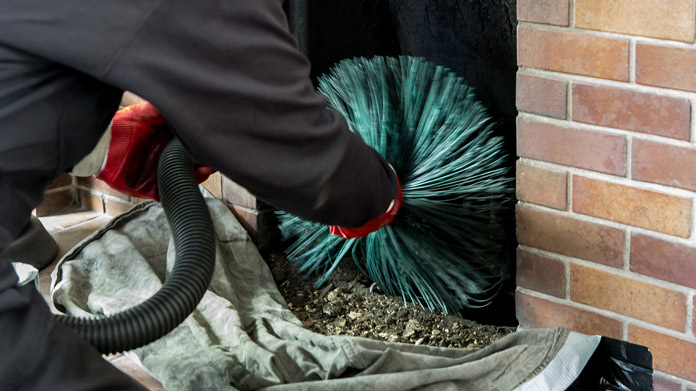The Comprehensive Guide to Chimney Maintenance San Jose: Trick Tips for Home Safety And Security
The Comprehensive Guide to Chimney Maintenance San Jose: Trick Tips for Home Safety And Security
Blog Article
Expert Tips for Effective Smokeshaft Upkeep You Need to Know
Smokeshafts serve as vital components in many homes, giving warmth and comfort. From the significance of regular inspections to safe operational techniques, a thorough technique to chimney upkeep is vital.
Significance of Normal Assessments
Regular examinations of chimneys are essential for guaranteeing their safety and capability. Chimneys play a critical function in airing vent out damaging gases and maintaining appropriate airflow in a home. Gradually, creosote buildup, particles, and architectural damage can take place within the chimney, posturing severe threats such as chimney fires or carbon monoxide gas leaks.
Throughout a chimney assessment, trained specialists examine the condition of the chimney, seeking any type of indicators of damage, obstructions, or damage. They likewise examine the integrity of the flue, smokeshaft liner, and chimney cap to make certain everything remains in appropriate functioning order. By determining and resolving concerns beforehand, prospective hazards or expensive repair services can be stayed clear of.
Regular evaluations not only assist in keeping the safety and security of the chimney but also add to its general performance. A tidy and properly maintained chimney operates better, making sure correct air flow and lowering the threat of interior air contamination. Scheduling yearly smokeshaft examinations is an aggressive action that home owners can take to secure their building and liked ones.
Cleaning Techniques and Frequency
Keeping the security and effectiveness of a chimney entails not just routine inspections yet additionally applying proper cleaning techniques and establishing the ideal frequency for cleansing. Smokeshafts should be cleansed by an expert chimney move a minimum of as soon as a year, even if they are not often utilized. If the smokeshaft is used regularly, specifically with wood-burning ranges or fire places, it may call for more regular cleansings to avoid the build-up of creosote, an extremely combustible substance that can lead to chimney fires.
Home owners need to never ever neglect chimney cleansing, as it is crucial for maintaining a safe and functional smokeshaft system. Normal cleansings not just lower the threat of smokeshaft fires yet also improve the chimney's overall performance and longevity.
Attending To Chimney Leaks

When addressing chimney leaks, comprehensive assessment and timely repair services are critical to protect against water damages and keep the architectural stability of the smokeshaft. Leakages in a chimney can lead to major problems such as mold growth, wear and tear of the chimney structure, and even potential fire hazards. To effectively resolve smokeshaft leakages, begin by examining the smokeshaft cap, crown, blinking, and masonry for any signs of damages or wear.
Comprehending Creosote Build-Up
To understand the possible dangers of creosote build-up in chimneys, it is important to identify its development process and effect on smokeshaft performance. Creosote is a brownish or black tar-like compound that accumulates inside smokeshaft systems when wood or nonrenewable fuel sources are melted. As smoke rises via the chimney, it cools down and condenses, leading to the development of creosote, which follows the smokeshaft walls.

Regular chimney examinations and cleanings by an expert chimney sweeper are important in stopping creosote build-up and guaranteeing the safe operation of your smokeshaft system.
Safe Procedure Practices
Applying correct safety and security methods is crucial for the reliable and my site safe operation of smokeshaft systems. When making use of a fireplace or wood-burning range, it is essential to follow details safety and security methods to avoid potential threats. To start with, always guarantee that the smokeshaft is skillfully checked and cleaned regularly to get rid of any type of creosote buildup, which can bring about chimney fires. Additionally, make use of a durable display or glass door in front of the fire place to stop embers or triggers from leaving and creating a fire in your home. It is additionally essential to never overload the fireplace with too much amounts of timber, as this can lead to overheating and prospective architectural damage.
Furthermore, see to it to just melt seasoned wood in your fireplace, as damp or environment-friendly wood can produce more creosote and trigger unsafe smokeshaft blockages. Never ever leave a fire unattended and always make sure the fire is completely extinguished before going to bed or leaving Related Site the home. By complying with these risk-free operation methods, you can take pleasure in a warm and relaxing fire while making sure the security of your home and loved ones.
Conclusion
In final thought, maintaining your chimney is important for guaranteeing its safety and performance. Routine examinations, appropriate cleansing methods, resolving leaks, taking care of creosote build-up, and adhering to safe procedure techniques are essential facets of chimney upkeep.
Over time, creosote build-up, debris, and architectural damage can happen within the smokeshaft, positioning significant risks such as chimney fires or carbon monoxide leakages.
If the chimney is utilized regularly, particularly with wood-burning cooktops or fireplaces, it may call for even more constant cleanings to avoid the build-up of creosote, an extremely flammable material that can visit the site lead to smokeshaft fires. (Chimney Maintenance San Jose)
To understand the prospective threats of creosote build-up in chimneys, it is vital to identify its formation process and effect on smokeshaft performance. As smoke rises with the smokeshaft, it cools down and condenses, leading to the development of creosote, which adheres to the chimney walls.
Always make sure that the smokeshaft is properly inspected and cleaned on a regular basis to get rid of any kind of creosote buildup, which can lead to chimney fires.
Report this page